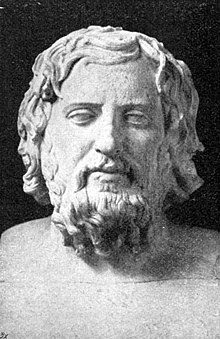色諾芬
| 色諾芬 | |
|---|---|
 | |
| 出生 | 約前431年 雅典 |
| 逝世 | 前355年 科林斯 |
| 地區 | 軍事家、文史學家 |
| 學派 | 蘇格拉底派 |
主要領域 | 軍事學、文史學 |
受影響於 | |
色諾芬(Ξενοφών,前427年—前355年)雅典人。軍事家,文史學家。他以記錄當時的希臘歷史、蘇格拉底語錄而著稱。
蘇格拉底的學生[編輯]
色諾芬的出生日期不詳。考古學者認為,公元前431年他出生於雅典附近的阿提卡地區。色諾芬出生在上層社會家庭,因此享有一些貴族特權。早年師從蘇格拉底學習,是蘇格拉底比較出色的學生之一。
傳奇的長征經歷[編輯]
前401年,波斯帝國西部小亞細亞的長官小居魯士在希臘招募僱傭軍,約三十多歲的色諾芬應募。當時招募的這支軍隊大約一萬餘人。此後這支軍隊在不知情的情況下,被小居魯士帶領向波斯帝國腹地前進,當到達塔爾蘇斯時,士兵們才得知了小居魯士的陰謀——推翻波斯國王,自立為王。希臘僱傭軍一方面沒有退路,另一方面收到小居魯士的許多許諾,繼續前進至巴比倫附近。但是小居魯士在戰鬥中身亡,由此這支希臘僱傭軍陷入波斯帝國腹地。而後來軍隊的首領又被波斯人誘捕而殺害,色諾芬被推舉出來領導這軍隊。在以後的一年裡,色諾芬帶領這支僱傭軍,歷經千難萬險,穿越大半個波斯帝國,終於回到希臘本土。
晚年的色諾芬自己著書《長征記》詳盡記述了這傳奇經歷。亞歷山大大帝向波斯進軍時,將此書視為戰地手冊。
在斯奇盧斯的生活[編輯]
回到希臘後,色諾芬投靠斯巴達。為斯巴達國王阿格西萊二世效力。前399年,色諾芬的老師蘇格拉底在雅典被處死,雅典政府也對色諾芬宣布了放逐令。前394年,色諾芬隨阿格西萊二世回到了斯巴達,在那裡與妻兒團聚。斯巴達政府把色諾芬安排在奧林匹亞附近的斯奇盧斯(Scillus)地方,以後,色諾芬在那裡平靜地生活了約二十年,在這二十年裡,他撰寫了很多著作。
晚年[編輯]
前371年伊利斯人攻占斯奇盧斯,色諾芬全家逃往科林斯。前369年,雅典與斯巴達關係改善,雅典政府取消了對色諾芬的放逐令,色諾芬將自己的孩子送回雅典,自己也經常短暫回雅典,但最終死於科林斯。
主要作品[編輯]
色諾芬是古希臘最偉大的作家之一。他以他個人的傳奇經歷寫成《長征記》,既是出色的文學史學作品,也是出色的軍事學作品。從文學角度上說,這部作品引人入勝,扣人心弦。從史學角度上說,它記述了波斯帝國和希臘當時各各方面的情況。而從軍事學角度上說,有人甚至稱讚此書「經過了二十三個世紀,還沒有比《長征記》更好的軍事教程」。
色諾芬撰寫了《希臘史》,成就了他作為古希臘偉大的歷史學家的名聲。此書記載了 前411年至前362年的希臘歷史。也有批評者認為,色諾芬在作品中明顯袒護斯巴達方面,傾向於反對雅典的民主制度。另外,色諾芬也著有斯巴達國王《阿格西萊傳》,傾向於為這位國王歌功頌德。
作為蘇格拉底的學生,色諾芬對老師懷有深厚的感情,他著有《回憶蘇格拉底》、《蘇格拉底的辯護》、《會飲篇》等。
色諾芬比較有名的作品還有《居魯士的教育》,色諾芬借波斯帝國開國君主居魯士之名,撰寫他自己的政治理想。
晚年雅典政府取消了對色諾芬的放逐令的後,可能作為回報,色諾芬寫了《雅典的收入》,這是一份提供給雅典政府的經濟上的建議書,也可看作最早的政治經濟學論文。
色諾芬的《經濟論》論述了奴隸主如何管理農莊,如何增加具有實用價值的財富。色諾芬十分重視農業,認為農業是希臘自由民的最好職業,這對古羅馬的經濟思想和日後法國重農學派都有影響。
主要作品[編輯]
歷史與傳記作品
- 長征記,崔金戎 譯,北京:商務印書館,1985年5月,ISBN 7-100-01792-0,
- 居魯士的教育,沈默 譯,北京:華夏出版社,2007年6月,ISBN 9787508041902 ,
- 希臘史
- 阿格西萊傳
蘇格拉底作品與對話錄
參考文獻及延伸閱讀[編輯]
- Bradley, Patrick J. "Irony and the Narrator in Xenophon's Anabasis", in Xenophon. Ed. Vivienne J. Gray. Oxford University Press, 2010 (ISBN 13: 978-0-19-921618-5; ISBN 0-19-921618-5).
- Anderson, J.K. Xenophon. London: Duckworth, 2001 (paperback, ISBN 1-85399-619-X).
- Xénophon et Socrate: actes du colloque d'Aix-en-Provence (6-9 novembre 2003). Ed. par Narcy, Michel and Alonso Tordesillas. Paris: J. Vrin, 2008. 322 p. Bibliothèque d'histoire de la philosophie. Nouvelle série, ISBN 978-2-7116-1987-0.
- Dillery, John. Xenophon and the History of His Times. London; New York: Routledge, 1995 (hardcover, ISBN 0-415-09139-X).
- Evans, R.L.S. "Xenophon" in The Dictionary of Literary Biography: Greek Writers. Ed.Ward Briggs. Vol. 176, 1997.
- Gray, V.J. "The Years 375 to 371 BC: A Case Study in the Reliability of Diodorus Siculus and Xenophon, The Classical Quarterly, Vol. 30, No. 2. (1980), pp. 306–326.
- Higgins, William Edward. Xenophon the Athenian: The Problem of the Individual and the Society of the "Polis". Albany: State University of New York Press, 1977 (hardcover, ISBN 0-87395-369-X).
- Hirsch, Steven W. The Friendship of the Barbarians: Xenophon and the Persian Empire. Hanover; London: University Press of New England, 1985 (hardcover, ISBN 0-87451-322-7).
- Hutchinson, Godfrey. Xenophon and the Art of Command. London: Greenhill Books, 2000 (hardcover, ISBN 1-85367-417-6).
- The Long March: Xenophon and the Ten Thousand, edited by Robin Lane Fox. New Heaven, Connecticut; London: Yale University Press, 2004 (hardcover, ISBN 0-300-10403-0).
- Kierkegaard, Søren A. The Concept of Irony with Continual Reference to Socrates. Princeton: Princeton University Press, 1992 (ISBN 978-069-102072-3)
- Moles, J.L. "Xenophon and Callicratidas", The Journal of Hellenic Studies, Vol. 114. (1994), pp. 70–84.
- Nadon, Christopher. Xenophon's Prince: Republic and Empire in the "Cyropaedia". Berkeley; Los Angeles; London: University of California Press, 2001 (hardcover, ISBN 0-520-22404-3).
- Nussbaum, G.B. The Ten Thousand: A Study in Social Organization and Action in Xenophon's "Anabasis". (Social and Economic Commentaries on Classical Texts; 4). Leiden: E.J. Brill, 1967.
- Phillips, A.A & Willcock M.M. Xenophon & Arrian On Hunting With Hounds, contains Cynegeticus original texts, translations & commentary. Warminster: Aris & Phillips Ltd., 1999 (paperback ISBN 0-85668-706-5).
- Rahn, Peter J. "Xenophon's Developing Historiography", Transactions and Proceedings of the American Philological Association, Vol. 102. (1971), pp. 497–508.
- Rood, Tim. The Sea! The Sea!: The Shout of the Ten Thousand in the Modern Imagination. London: Duckworth Publishing, 2004 (paperback, ISBN 0-7156-3308-2); Woodstock, New York; New York: The Overlook Press, (hardcover, ISBN 1-58567-664-0); 2006 (paperback, ISBN 1-58567-824-4).
- Strauss, Leo. Xenophon's Socrates. Ithaca, New York; London: Cornell University Press, 1972 (hardcover, ISBN 0-8014-0712-5); South Bend, Indiana: St. Augustines Press, 2004 (paperback, ISBN 1-58731-966-7).
- Stronk, J.P. The Ten Thousand in Thrace: An Archaeological and Historical Commenary on Xenophon's Anabasis, Books VI, iii–vi – VIII (Amsterdam Classical Monographs; 2). Amsterdam: J.C. Gieben, 1995 (hardcover, ISBN 90-5063-396-X).
- Usher, S. "Xenophon, Critias and Theramenes", The Journal of Hellenic Studies, Vol. 88. (1968), pp. 128–135.
- Waterfield, Robin. Xenophon's Retreat: Greece, Persia and the End of the Golden Age. Cambridge, Massachusetts: The Belknap Press of Harvard University Press, 2006 (hardcover, ISBN 0-674-02356-0); London: Faber and Faber, 2006 (hardcover, ISBN 978-0-571-22383-1).
- Xenophon, Cyropaedia, translated by Walter Miller. Harvard University Press, 1914, ISBN 978-0-674-99057-9, ISBN 0-674-99057-9 (books 1-5) and ISBN 978-0-674-99058-6, ISBN 0-674-99058-7 (books 5-8).
外部連結[編輯]
| 維基文庫中該作者的作品: 色諾芬 |
| 希臘語維基文庫中相關的原始文獻: Ξενοφῶν |
| 維基語錄上的Xenophon語錄 |
| 維基共享資源上的相關多媒體資源:色諾芬 |
| 關於Xenophon 的圖書館資源 |
| Xenophon的作品 |
|---|
- Xenophon. 《網際網路哲學百科全書》.
- Graham Oliver's Xenophon Homepage
- Xenophon's Education of Cyrus (Cyropaedia) Web directory
- Famous Quotes by Xenophon (頁面存檔備份,存於網際網路檔案館)
- Sanders (1903) Ph D Thesis on The Cynegeticus
- Xenophon (頁面存檔備份,存於網際網路檔案館) at Somni (頁面存檔備份,存於網際網路檔案館)
- 在線電子書
- Works by Xenophon at Perseus Digital Library (頁面存檔備份,存於網際網路檔案館)
- Links to English translations of Xenophon's works (頁面存檔備份,存於網際網路檔案館)
- Leo Strauss' Seminar Transcripts on Xenophon (1962, 1966); and an audio recording of the entire course on Xenophon's Oeconomicus (1969) are available for reading, listening or download.
- 色諾芬的作品 - 古騰堡計劃
- 網際網路檔案館中色諾芬的作品或與之相關的作品
 來自色諾芬的LibriVox公共領域有聲讀物
來自色諾芬的LibriVox公共領域有聲讀物
| ||||||||||||||||||||||||||||||||||||||||||||||||||||||||||||||||||||||||||||||||||||||||||||||||||||||||||||||||||||||||||||||||||||||||||||||||||||||||||||||||||||||||||||||||||||||||||||||||||||||
| ||||||||||||||||||||||||||||||||

